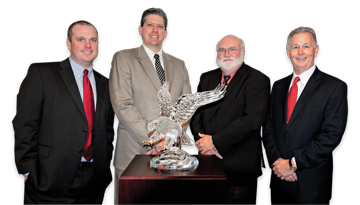Winning in the USA
How three ISA member companies helped a Florida machine shop outshine global competitors
by Rich Vurva
 |
|
Left to right: DGI Supply chief operating officer Bill Henricks, SGS director of sales Bart Carter, SGS sales engineer Chris Sparks, and DGI senior vice president David Crawford pose with their American Eagle award. |
There is no margin for error when machining parts used in the aerospace industry. Aerospace manufacturers are among the most demanding customers for component suppliers, requiring them to provide parts machined to very close tolerances using difficult-to-machine metals.
The industry is also highly competitive. Dozens of companies worldwide often bid for the chance to win a project to supply a specific part to an aircraft manufacturer. The winners are chosen only after they demonstrate not only that they can meet precision machining requirements, but that they can do so in the most cost-effective manner possible.
That is the situation in which a Southwest Florida machine shop found itself last fall. The company, a high-precision job shop with a reputation for accepting projects requiring tight tolerances, had an opportunity to win a multi-year contract from a major European
aerospace manufacturer. The job required machining a brake component made from titanium, which is more challenging to machine than most metals that machine shops traditionally encounter.
Early attempts using a seven-flute end mill required two passes to complete the cut of a torque tube measuring 10 inches in diameter and 14 inches long. The total cycle time to complete the cut was more than 43 minutes. Unless the machine shop could dramatically reduce cycle time, but maintain a superior surface finish, it would likely lose the contract to a competitor.
Prototype solution
The answer to the riddle was found by an attentive salesman from DGI Supply.
Unknown to the machine shop, representatives from SGS Tool Company, a manufacturer of solid carbide rotary cutting tools, had been testing a new multi-flute end mill that was still in research and development.
During a regional training and planning meeting with sales engineers from distributor DGI Supply and manufacturer representatives John Pittman and Dave Hamp of Pittman Industrial Marketing, SGS regional sales manager Cliff Carrignan mentioned that the company was looking for a chance to test the still unnamed tool in a production environment. DGI Supply salesman Kent Skyrms offered to set up a meeting between the precision machine shop and SGS sales engineer Chris Sparks.
After learning more details about the project, Sparks was reasonably confident that the new Multi-Carb multi-flute tool, as the tool was eventually named, could perform better than the tool currently being used.
Since the tool that Sparks recommended was still in R&D, it meant that production tools wouldn’t be available for another six to eight months. Unable to wait that long, Sparks worked closely with the SGS Tool Company manufacturing team and product manager Jason Wells in Munroe Falls, Ohio, to get prototype tools for testing.
“In late 2011, we had oversold capacity, meaning we had more tool orders than machine capacity. For us to even make a couple of tools was extremely difficult because it would take time away from making standard tools that were being sold as fast as we could make them. We had to crowbar it into manufacturing because we knew this was a huge opportunity,” explains Bart Carter, SGS director of sales.
Carter recognized this as another opportunity for SGS to demonstrate “value at the spindle.” He says SGS welcomes every opportunity to spend time on the shop floor to demonstrate the value of SGS to the end-user and to generate revenue for distribution partners.
The production team assembled three prototype tools that Sparks took with him to Florida. He was convinced that the tools would work better than the incumbent supplier’s product, but still had that nervous feeling any sales engineer gets when testing a tool for the first time in a real-world setting. Would the tool do the job? Would the three sample tools last long enough to finish the production run? Would the customer be willing to make additional programming changes so the new tool would work at optimum levels?
Within just a few seconds after the tool started its first cut, Sparks breathed a sigh of relief. “I could tell it was a winner,” he says. With no telltale chatter or harmonics issues that could impact finish or tool life, the final hurdle to cross was durability. Would the test tools last long enough to complete the order of seven finished parts? The competitor’s cutting tool typically machined four parts per tool. The Multi-Carb completed all seven parts in that first test run.
Proof of performance
Following the first test, Sparks recommended making additional changes to cutting parameters, such as increasing feeds and speeds to obtain greater material removal in less time. He essentially rewrote the entire machining program to get the maximum benefit from the new tool. The final result was dramatic. The Multi-Carb multi-flute end mill completed the cut in one pass instead of two. It cut at twice the axial depth of the competition at 204% greater feed rates, which equates to four times more metal removal at 25% of the original cycle time. Compared to the original cycle time of nearly 44 minutes, the new tool completed the job in less than 11 minutes.
The changes made to the application, combined with the performance of the multiple flute tool, resulted in a gain of 653 production hours (or 27.2 days per year) for the one part. In addition to meeting the goal of reduced cycle time, the tool life increased from four parts per tool to 25 parts per tool. The total annual cost savings for the one tool was more than $132,000. Cost-per-part was reduced from $141.54 to $31.69, a whopping 77.6% reduction, which ultimately enabled the machine shop to win a two-year contract from the European aerospace manufacturer. When the contract ends, the company may have an opportunity to win even more business, since the component is currently being supplied by more than one manufacturer.
The work performed by SGS Tool Company, DGI Supply and Pittman Industrial Marketing helped the companies earn the 2012 American Eagle Value-Added Partner Award from the Industrial Supply Association. Each year, ISA gives out the award at its annual Product Show & Conference in recognition of “the combined efforts of channel partners working together to show exceptional documented cost savings or productivity improvements for the end-user.”
 Bart Fellin, chairman of the ISA Awards and Recognition Subcommittee, called this year’s award “a classic example of maximum value that can be achieved when all partners in the supply chain work together as a unit. All three companies played an important role in bringing value to the end-user.”
Bart Fellin, chairman of the ISA Awards and Recognition Subcommittee, called this year’s award “a classic example of maximum value that can be achieved when all partners in the supply chain work together as a unit. All three companies played an important role in bringing value to the end-user.”
New tool, new revenue stream
Most examples of documented cost savings means someone in the distribution chain loses revenue in the short term. When cost savings are created, the end-user buys fewer tools, creating a short-term negative revenue impact on the supply chain. However, these cost savings help with customer retention and yield long-term profitability, which is why companies like SGS and DGI continue to look for cost savings at the end-user.
In this case, the dramatic productivity improvement resulted in a new revenue stream for everyone.
“This was new business for everybody so everyone was going to get a new revenue opportunity,” says Carter. “There was no loss in tooling and no reduction in inventory. As a result of a reduction in cycle time, the customer got the business, creating a new revenue opportunity for them, DGI Supply, SGS Tool and Pittman Industrial. The entire channel generated revenue.”
David Crawford, senior vice president with Wheeling, Ill.-based DGI Supply says this case study was just one of more than 2,444 projects that DGI completed in 2011, generating $9.4 million in cost savings.
“Part of the value we bring to our customers is helping them to find better sources of supply. As Kent Skyrms showed in this instance, we make it our business to know the supply options better than anyone else on the planet, even if those options are still experimental,” he says.
“Being a North American distributor and very proud of what we do here in the United States, we want to make sure we keep as much manufacturing as possible in this country. Being more productive on the shop floor helps keep more people employed in the U.S.”
This article originally appeared in the July/August 2012 issue of Industrial Supply magazine. Copyright 2012, Direct Business Media.













